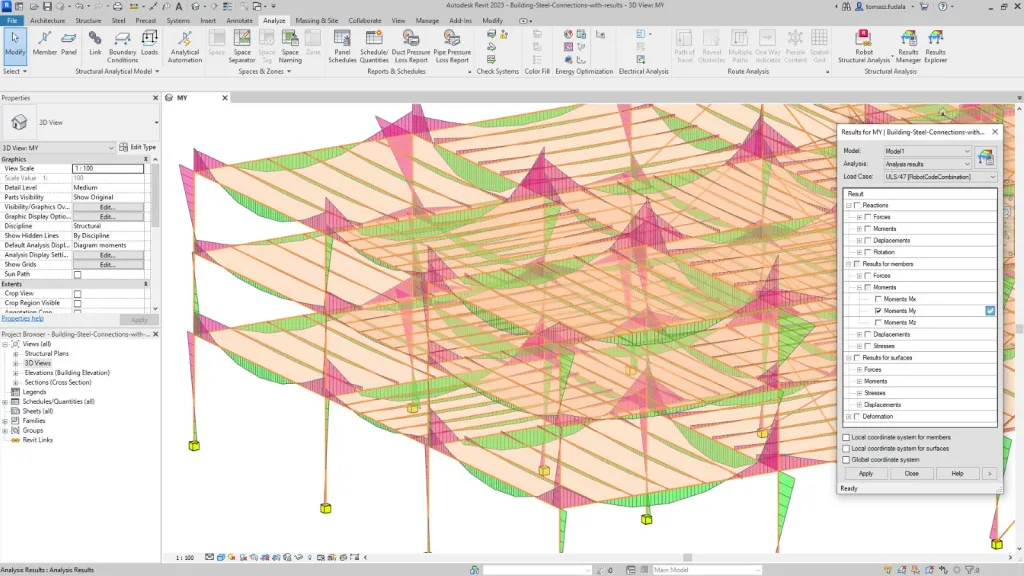Revit 2023: Library-Based Connection Design Automation
With Revit 2023, will help structural engineers working with typical steel buildings work faster and more precise, so that they could invest more in delivering more creative designs.
Reduced iterations with fabricators for connections modelling
Structural engineers and fabricators can blend their own specific rules into libraries of connections, which will serve as the single source of information for all new projects.
nnections proposed by the tables from the standards and the steel profiles to which they fit and the ranges of compatible member end forces. Single- or double-angles, shear end plates, seated connections, column splices, base plates, fin plates and many more typical connections like these are part of various Revit 2023 content packs, available via your Autodesk account portal or Autodesk Knowledge Network.
You can further expand or customize these libraries by creating new connection types, duplicating or editing the existing ones. It is during this step when you should reach out to the fabricators you work with and ask them to agree on the set of rules they would like to follow for the next projects, like using only connections with a particular bolt grade, avoiding any kind of chamfers, or having a preference for fin plates with 2 lines of bolts, rather than 1. Just to remove any confusion for my fellow engineers: these names that I’ve just used differ from country to country, even between USA and UK, some countries have certain connections standardized, other countries have different ones, and some have no official standardization. Still, the “Associate Connections with Profile Sizes” is meant to be a universal tool for all engineers to express the rules they need to respect for each steel connection type. And once all of these are saved in libraries, they can be reused across projects, saving countless hours and offering you the confidence that fabricators will have less RFIs addressed towards you. You could even think at turning the libraries of connections into contractual agreements.

Before wrapping up this section, let us tell you about the standards our sample libraries are based on: the AISC Steel Construction Manual 15th Edition and 14th Edition, the BCSA and SCI publication P358 – “Joints in Steel Construction – Simple Joints to Eurocode 3” – 2014 Edition (also known as the Green Book), and the German DSTV – “Standardized Joints in Steel Structures to DIN EN 1993-1-8” (“Typisierte Anschlüsse im Stahlhochbau nach DIN EN 1993-1-8”) – 2013 Edition.
Faster design intent modelling
Imagine how easy it is to create the design intent model with steel connections, when you can take off the shelf the required ones and place them in the model, based on automation algorithms.
Having the libraries defined, the next steps of Connection Automation keep you on the track for a simple, connected workflow: start from your new Revit design intent model, transfer it to Autodesk Robot Structural Analysis Professional or other analysis software that can exchange analysis results with Revit to perform the structural analysis and bring it back to Revit.

Having the libraries defined, the next steps of Connection Automation keep you on the track for a simple, connected workflow: start from your new Revit design intent model, transfer it to Autodesk Robot Structural Analysis Professional or other analysis software that can exchange analysis results with Revit to perform the structural analysis and bring it back to Revit.
Just in case you may think performance would become an issue when dealing with so many connections, it’s worth saying that in Revit 2023 the overall performance of navigation in all views has been improved, our benchmark tests reporting an average improvement of 35% for more than 100 affected test cases. Moreover, the Analytical Model in Revit is now created on demand when needed, which means creating and editing detailed models with steel connections is up to 50% faster.
Estimate earlier: the constructability and cost for entire models with connections
Since connections can now be placed much faster, it means that more detailed design models, with connections, can be created quicker too. This empowers engineers to estimate faster and more accurately their proposal before submitting it for a tender, increasing their competitiveness. It gives you time to do more iterations on the design and takes away part of the tedious stage of modelling connections.
Constructability can be assessed earlier as well, because once connections are modelled, one can easily do a clash check using Autodesk BIM Collaborate. This way, the early design will be much closer to the final detailed model, by comparison to a traditional workflow
New business opportunities to extend services to detailing
Having an accelerated process of the design intent model with connections, and having the ability to embed within the steel connection types and within the placement rules the various bespoke requirements of fabricators and of other project stakeholders, it might make sense to some engineers to increase the value of their services, by expanding into detailing. The Revit models would be richer in BIM data, in a phase almost similar to that which only detailers typically reach. Transfer the model to Advance Steel, add the remaining fabrication-specific logic and automatically create the shop drawings and NC files.
Contractual agreements and industry practices don’t change overnight, but they are not set in stone either. They evolve, just like us, based on the knowledge we all amass day by day. This is what the visionaries from the industry have taught us, and this is why we put our effort in delivering these new tools. So that structural engineers can work more efficiently and deliver more value.